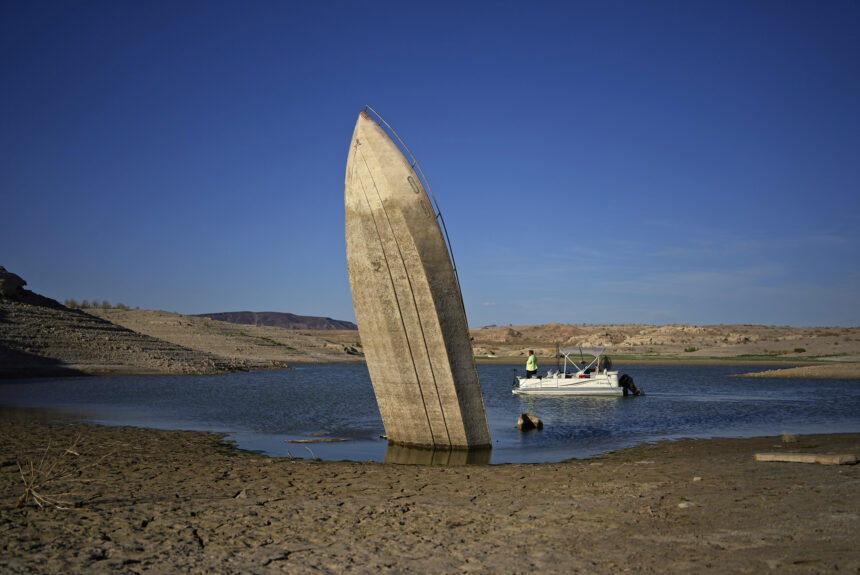Extreme rainstorms in California resulted in landslides and flooding up and down the coast, but along with a strong snowpack in the Sierra Nevadas, offered a bit of relief from significant drought in the western United States. Even so, the issue of water scarcity remains a pressing concern as the drought has drained reservoirs like Lake Mead to record lows.
>>>READ: A Canadian Startup Builds Nuclear Fusion Power Plant
“Lake Mead is more than 180 feet below its “full level” and hasn’t been close to full since 1999,” says Dr. Joeleen Russell, a climate scientist and professor at the University of Arizona. “It would take several years of much-above average snowpack (unlikely given the warming temperatures), combined with drastically less water usage to let Lake Mead begin to fill again.”
The private sector is stepping up to offer solutions. Several companies are reducing water use through efficiency investments, while others are looking to replenish water levels in local communities. Here are three companies that are leading in addressing water scarcity.
NextEra
Energy giant NextEra Energy has launched NextEra Distributed Water, a subsidiary that specializes in water management solutions. The company helps its partners reclaim and reuse wastewater for non-potable purposes such as toilet flushing, irrigation, and heating and cooling with its innovative WaterHub system. NextEra boasts turn-key project financing: the company will deploy its WaterHubs with no development, construction or performance risk while at the same time assuming all operational and maintenance responsibilities.
NextEra has successfully partnered with Emory University to facilitate “campus-wide water reclamation and reuse.” NextEra collects up to 400,000 gallons of wastewater per day from the campus sewer system, cleans it (using solar energy production), and then distributes the recycled water back to campus buildings for toilet flushing. Through NextEra’s WaterHub, Emory has reduced potable water consumption by ~146 million gallons per year.
Google has committed to replenish, on average, 120% of the water it uses by 2030. The company has already implemented water-saving strategies: in Douglas County, Georgia, data centers are being cooled with reclaimed wastewater. Google hopes to expand this policy of using freshwater alternatives to cool data centers and plans to either use reclaimed wastewater or seawater. Similarly, Google aims to supply its offices with collected stormwater and treated wastewater for toilet flushing, cooling, and watering its landscapes.
Microsoft
Microsoft has pledged to be water positive by 2030, which means that it will produce more water than it consumes. The company has started to invest in new technologies to reduce the amount of water consumed to cool and power data centers. Smart Water Navigator is one of the tools that Microsoft has deployed to get their consumption in check. This water management platform provides an assessment of a company’s water consumption and then supplies a detailed and industry-specific plan to optimize water usage.
Microsoft also cools its data centers with adiabatic cooling, which uses outside air rather than water for cooling when temperatures are less than 85 degrees Fahrenheit. One data center in Arizona was able to operate without consuming water for cooling for more than half the year.
>>>READ: GM, Ford, Google Team Up to Advance ‘Virtual’ Power Plants
As the private sector addresses concerns around water stress and water scarcity, it will be important to note where companies are focusing their efforts.
“Conservation or replenishing, these are good strategies — they are definitely worth tracking and monitoring and evaluating for companies as a management practice,” says Kata Molnar, a water thematic expert at Morningstar Sustainalytics. “You have to look into whether those actions happened in the watersheds where the company has real presence and influence.”
This is particularly relevant to the western United States, which supports populations in semi-arid climates as well as deserts. Phoenix, for example, is located in the Sonoran Desert and supports a population of 1.7 million. Las Vegas, located in the Mojave Desert, supports 625,000.
As the symptoms of climate change continue to become more prominent, these areas will require more and more attention. Water stress and water scarcity will need to become a central component of the discussion around climate change for these areas to continue to be hospitable.
The Property and Environmental Research Center (PERC) is looking into possible solutions. In September the group unveiled a white paper titled “The Future of Water Markets” which explores how markets can be used to address water scarcity needs and encourage conservation.
With the need to address water scarcity becoming prevalent, private sector leaders are stepping up to offer long-term solutions.
Luke Brennan is a writer and software developer originally from Pittsburgh.
The views and opinions expressed are those of the author’s and do not necessarily reflect the official policy or position of C3.
